Headquartered in Stockholm, Sweden, Blueair is the leading provider of air purification solutions for people who want to breathe clean air and live healthier lives. Sold in countries all over the world, our high-performance air purification solutions are energy-efficient and responsibly made. Through our unwavering commitment to excellence, research and constant innovation, Blueair is shaping the way the world breathes to make people feel more alert and alive – today and tomorrow.
Data and information in this document is considered to be correct at the date of publication. Changes in circumstances after the time of publication may impact on the accuracy of the information. The Information may change without notice. While the Information in this document has been presented with all due care, Blueair AB does not warrant or represent that the Information is free from errors or omissions.
Although some pollutants that affect indoor air quality originate outdoors, most come from sources inside buildings. While some are naturally occurring, such as dust, molds, pollen, viruses and pet dander, others are man-made. Activities such as cooking and heating produce pollutants, as do materials commonly used in our homes. All of these have the potential to harm our health.
Blueair’s team of talented designers, filtration specialists, engineers and researchers have consistently chartered new directions and pushed the envelope in innovation. This quest for clean air has resulted in purification systems that deliver top rated results, while never making a noise louder than a whisper. Here, we take a closer look at Blueair’s revolutionary filtration technology.
Filtration efficiency
The efficiency of an air purifier is measured on the amount of pollutants that are removed from the air after it has pass through the filter once.
Clean air delivery rate
The amount of clean air produced by an air purifier per unit of time
Blueair’s air purifiers use the trademarked HEPASilent™ filtration technology. This combines two types of particle filtration, electrostatic and mechanical, resulting in a filtration efficiency superior to either technology alone. Due to this combination, Blueair’s air purifiers are able to use less dense filters, resulting in a high airflow and thereby a high Clean Air Delivery Rate (CADR). Less dense filter media and high airflow also ensure lower noise levels and energy consumption.
Blueair’s HEPASilent™ technology captures at least 99.97% of airborne particles down to 0.1 microns in size.
The HEPASilentPlus™ technology includes an additional filter where larger particles are removed. Since that leaves fewer particles needing to be charged in the electrostatic filtering process, each particle receives a higher charge which further increases the unit’s filtration efficiency.
Read more about the HEPASilent™ technology in the Particle removal chapter.
Blueair’s HEPASilent Technology is able to capture at least 99.97% of airborne particles down to 0.1 microns in size. This graph shows the filtration process, as well as how and where different types of pollution particles are efficiently captured.
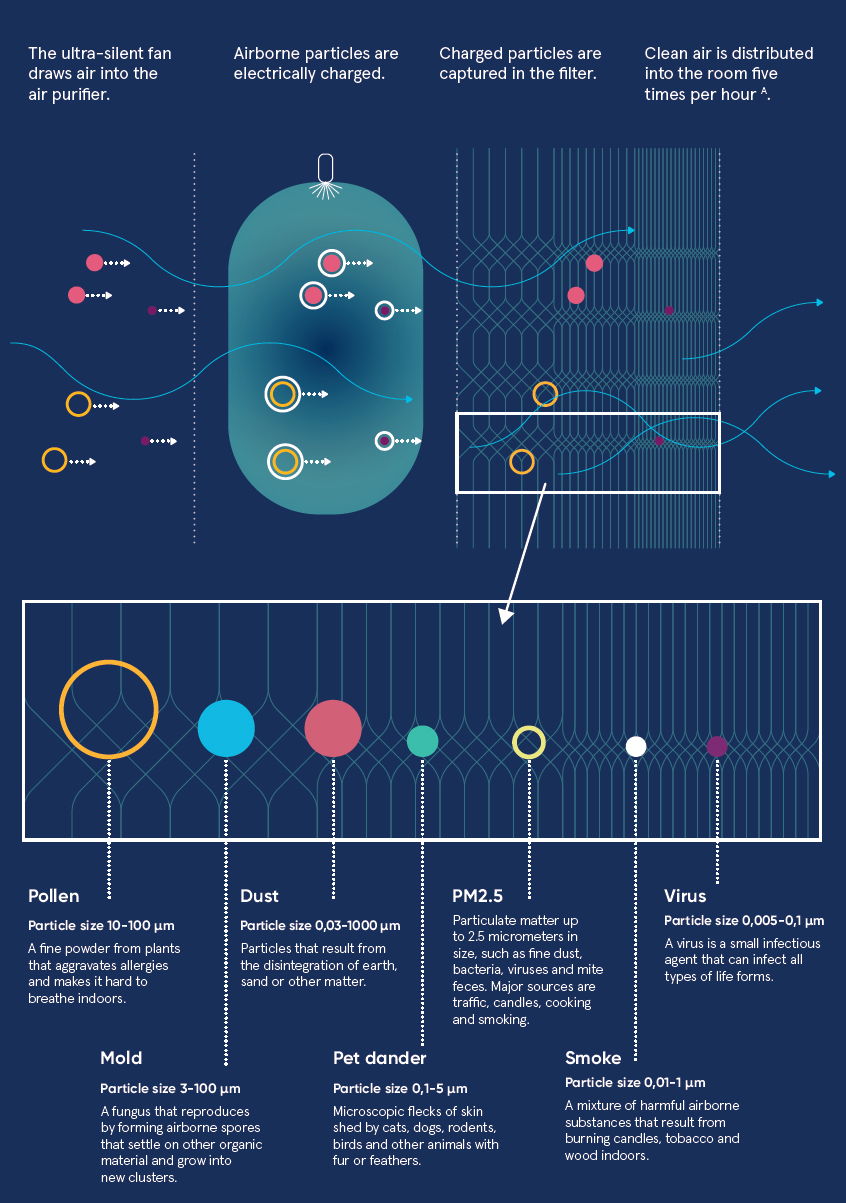
TVOC (Total Volatile Organic Compounds) is a measurement of the total concentration of VOC’s in the air.
PM0.3 is particulate matter that is 0.3 microns or less in diameter. These particles penetrate deep into the respiratory system, causing lung disease.
When choosing an air purifier, performance should be considered first. Blueair units are top performers in reducing indoor air pollution. The two major factors that should always be viewed together when evaluating the total performance of an air purifier are its ability to remove impurities in the air and the size of its airflow. Combined these determine how much clean air the air purifier produces.
CADR stands for Clean Air Delivery Rate and is measured in cubic feet per minute, or cubic meters per hour. This measurement indicates how much 100% clean air is
delivered by the air purifier and how well the system removes impurities from the air. The higher the CADR value, the more clean air is produced by the air purifier and the better it will be at cleaning the air in a room. Clean Air Delivery Rate can be measured for both particles and gases.
There are different methods and standards for measuring and calculating the CADR value of an air purifier. Some methods focus on particle removal and some on removal of gaseous pollutants, while some measure both. The different methods may result in different CADR values. However, the CADR value will make it easier for the consumer to compare the performance of air purifiers tested according to the same method. Blueair products are tested according to various globally and locally used CADR standards. In China, tests on formaldehyde, VOC’s and tobacco smoke are used to determine the CADR values. Potassium chloride (PM0.3) is measured in Korea. Dust and tobacco smoke is tested in Japan, and the Association of Home Appliance Manufacturers (AHAM) use tobacco smoke, dust and pollen to determine the CADR for different sizes of pollutants.
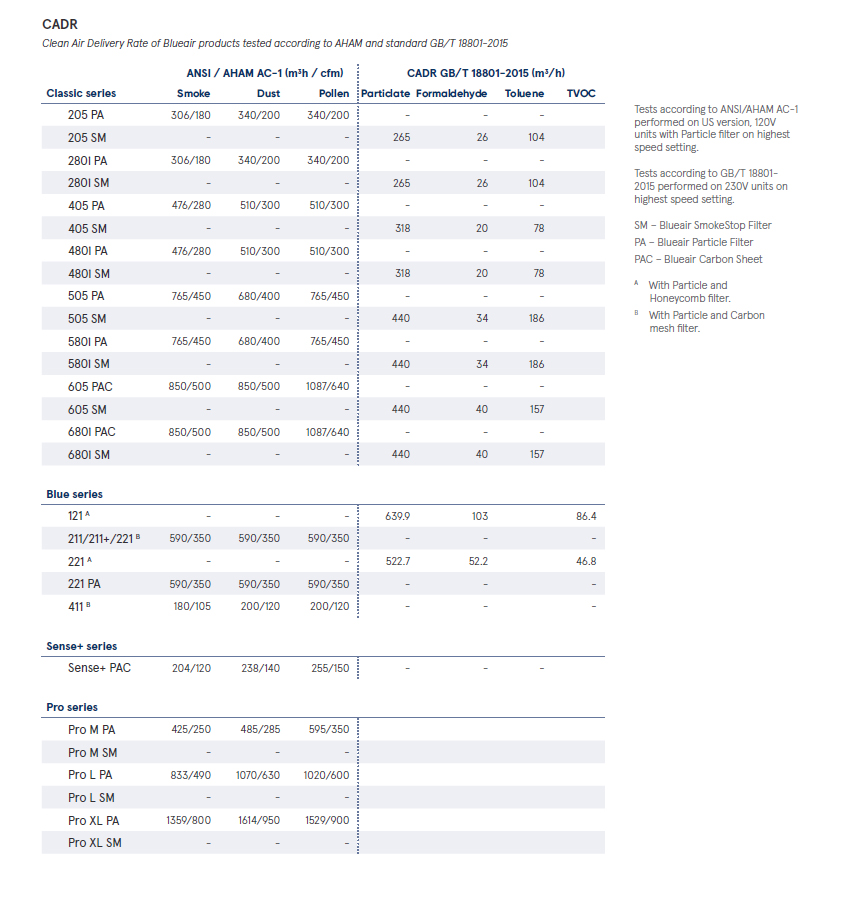
Blueair units are designed for use in all types of environments, from small bedrooms to large open areas. The basic task of an air purifier is to remove the pollutants from the indoor air faster than they enter. To achieve this, it is necessary to choose a unit suitable for the size of the room where it is to be be used.
In normal indoor situations polluted air is constantly entered in to the room through ventilation or poorly sealed windows. An easy way to find out if an air purifier has the capacity to keep the air in the intended room constantly clean is to look at its recommended room size. In general, an air purifier with a higher clean air delivery rate will be able to clean a larger room than an air purifier with a lower clean air delivery rate.
Different standards have different methods for calculating the recommended room size. According to the standard ANSI/ AHAM AC-1, the maximum room size recommendation is based on the air purifier’s clean air delivery rate, using the formula CADR (for smoke) x 1.55, and on its possibility to keep the particle levels in the air constantly 80% lower than without an air purifier. In order to keep the amount of airborne particles at a constant level, the air purifier must, according to ANSI/AHAM AC-1, fully exchange all the air in the room five times per hour.
The Chinese standard GB/T 18801-2015 requires the recommended room size to be specified on the product’s rating label. The recommended room size is based on the unit’s CADR and takes local pollution variations into consideration. In order to keep the amount of airborne particles at a constant level, the air purifier must, according to GB/T 18801-2015, exchange the air in the room 3.6 or 6 times per hour, depending on whether it is used in less polluted or more polluted areas.
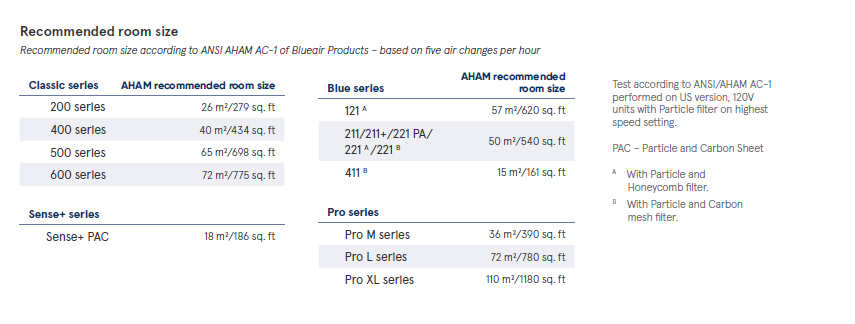
If the air purifier is placed in a larger room than it is recommended for, the number of air changes per hour (ACH) will be reduced and the air quality will be affected negatively. The opposite will be true if the air purifier is used in a room smaller than its recommended size.
The below chart shows how the particle levels in a room are affected by the number of air changes per hour (ACH) according to ANSI/AHAM AC-1. The graph shows that the particle levels are reduced by approximately 30% with one air change per hour, or 1 ACH.
With 5 ACH, the particle level is down approximately 80% compared to a room without an air purifier. When comparing air purifiers from different manufacturers, make sure that the recommended room sizes are comparable and most importantly that the stated room size is specified at the same ACH.
An AHAM verified Blueair air purifier delivers 5 air changes per hour, based on recommended room size, ensuring the air quality in a room is excellent.
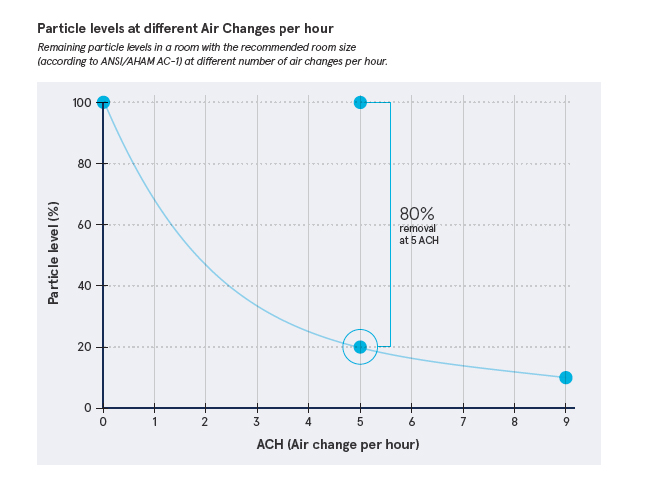
To ensure maximum performance, an air purifier should run 24 hours a day, seven days a week. For this reason, Blueair products are developed with low power consumption in mind, making sure environmental impact – as well as cost of ownership – is as low as possible.
The HEPASilent™ technology used in all Blueair air purifiers allows the fan to push air more easily through the unit’s filter. This ensures a high cleaning capacity also at lower fan speeds, resulting in lower power consumption. Naturally, air purifiers with a higher CADR, intended for use in larger areas, will have a higher power consumption than air purifiers for smaller areas. For this reason, the power consumption should always be compared to the CADR performance of the unit. A common way to compare the power consumption of different air purifiers is to look at the CADR/Watt measurement. The higher CADR/W, the better efficiency.
ENERGY STAR is a globally recognized program of the U.S. Environmental Protection Agency (EPA) and the U.S. Department of Energy. The program was developed to help consumers save money and to protect the environment through energy efficient products. Criteria required for ENERGY STAR qualification for air purifiers include CADR based on AHAM values, CADR/Watt, standby power usage and ozone emission. More specifically, to meet ENERGY STAR qualifications, units require a ≥ 50 cubic feet per hour Clean Air Delivery Rate (CADR) and a ≥ 2.0 Dust CADR/Watt for dust, as well as a ≤ 2.0 Watts standby power usage. Blueair was among the first air purifier manufacturers to earn the ENERGY STAR designation for all its models and thanks to their high CADR, Blueair air purifiers significantly exceed the minimum ENERGY STAR requirements.

Learn more about the ENERGY STAR program for air purifiers and find more information about Blueair’s ENERGY Star certified products in the Energy Star online directory at:
https://www.energystar.gov/products/appliances/air_purifiers_cleaners
Only products that meet the ENERGY STAR requirements and have become certified by ENERGY STAR are allowed to bear the ENERGY STAR Logo. The logo is placed on the product packaging or on unit and should be accompanied by the following statement:
This product earned the ENERGY STAR by meeting strict energy efficiency guidelines set by the US EPA. US EPA does not endorse any manufacturer claims of healthier indoor air from the use of this product.
In addition to being ENERGY STAR certified, Blueair products are also tested according to local energy efficiency programs such as MEPS (Minimum Energy Performance Standards) in Korea and GB/T 18801-2015 in China.
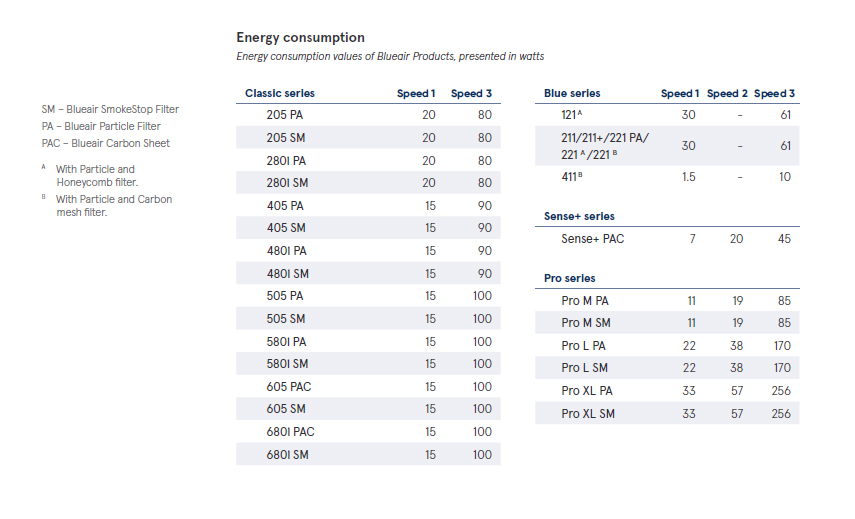
High noise can cause severe annoyance and can even affect health, causing physical and mental stress. Blueair’s HEPASilent™ technology is able to deliver high performance with low noise, making our units the perfect air purifiers for rooms where silence is desirable, such as bedrooms.
Noise from air purifiers generally comes from the fan or motor and the air pressure through the filter. Blueair’s whisper-silent operation is a result of the HEPASilent™ filtration technology and the use of less dense filters that allow the fan in our units to push air more easily through the filter, resulting in a high cleaning capacity while keeping the noise levels down.
When specifying an air purifier’s noise level, an A-weighted decibel value, or dB(A), is commonly used. This value indicates how the loudness is perceived by human ears. “A-weighted” means that the measurement compensates for the ear’s inability to perceive all acoustic frequencies in the same way.
It should be mentioned that the dB(A) value alone does not provide enough information in order to determine how “noisy” an air purifier is. The noise levels should always be seen in the light of the unit’s overall performance, such as CADR. The characteristics of noise, tone and how the individual subjectively perceives the noise also weigh in. Blueair puts emphasis on all these aspects during development in order to create the best overall user experience.
At Blueair’s testing facilities, all units are tested for noise by measuring A-weighted sound pressure levels, dB(A), in a normal sized room (around 74m³ or 2613 cubic feet in size). The testing room has a mix of soft and hard surfaces in order to simulate a normal living room or bedroom. See Appendix for Blueair product details.
Another way to measure noise is to measure the product’s sound power. Though using the same measuring unit of dB(A), sound power and sound pressure is measured and calculated in different ways and usually differ, even for a specific model. When sound power levels, dB(A), are required, Blueair performs tests according to ISO standard 3741:2010. These tests are done in a reverberation room with the volume 200 m³. See Appendix for Blueair product details.
Please note that the many different standards and methods for measuring sound can affect the sound levels and make comparing different models and brands more complicated.
The sound power is the acoustic energy emitted per unit of time by a source which creates a sound pressure at some distance. While the sound power level of a source is fixed, the sound pressure level depends upon the distance and direction from the source and the acoustic characteristics of the area in which it is located.
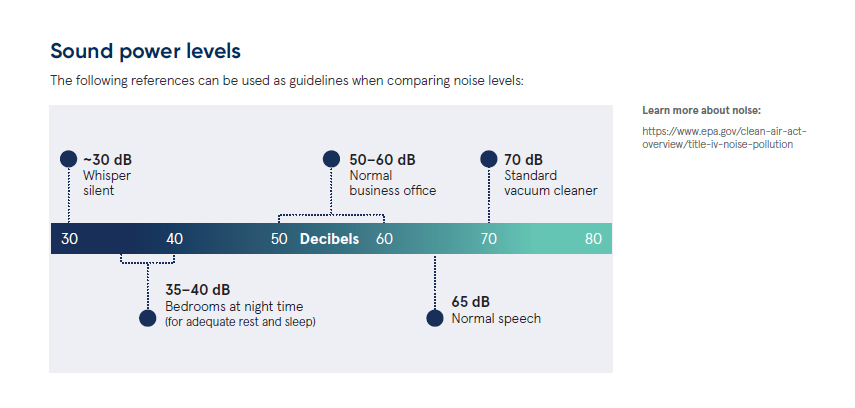
Air purifiers are designed to remove both ultra-fine and coarser particle pollutants from the air. Most particle pollutants come from the incomplete burning of fossil fuels in vehicle motors, industrial processes and power plants, from natural combustion sources like forest and brush fires, or from other natural sources such as dust, pollen, mold, pet dander, viruses and bacteria. Effective removal of these pollutants contributes to a healthier indoor environment.
Particulate matter, or PM, is the term for a mixture of solid particles and liquid droplets found in the air, whose major components are black carbon, sulfate, nitrates, ammonia, sodium chloride, mineral dust, and water. A synonym for particle matter commonly used when particles occur together with gases is aerosol.
The efficiency of a filter is measured on the amount of pollutants that are removed from the air after it has passed through the filter once. The more pollutants that are removed after one air change, the higher the efficiency. The HEPASilent™ filtration technology used in all Blueair products is highly efficient and captures at least 99.97% of particles down to 0.1 microns in size.